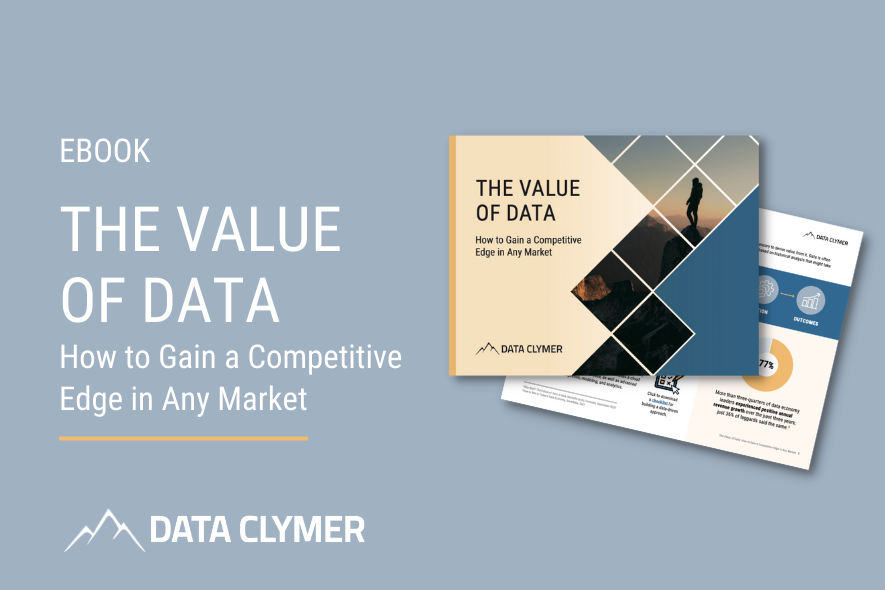“Do more with less” may well be the business motto of the year. (Or the decade, for that matter.) Businesses continued to grapple with economic uncertainty throughout 2023. Budgets grew tighter due to rising costs, reduced margins, technological disruption, and changing customer demands. Now, as we head into 2024, many organizations are asking how to improve operational efficiency to positively impact the bottom line.
The one-word answer: data. From increasing staff productivity to minimizing supply chain disruptions, your business data presents endless opportunities to improve operational efficiency across your organization.
Here are 4 ways to use data to improve operational efficiency in 2024—plus 4 operational efficiency examples to inspire you in the year ahead.
1: Optimize staffing.
![]() Labor is the biggest expense for most businesses. Using data can help organizations accurately match staffing with demand. For example, imagine a retailer who can accurately predict foot traffic at any given time and provide just the right amount of staffing. By proactively minimizing the risk of overstaffing or understaffing, the retailer not only optimizes resource allocation—it also improves customer service, satisfaction, and loyalty.
Labor is the biggest expense for most businesses. Using data can help organizations accurately match staffing with demand. For example, imagine a retailer who can accurately predict foot traffic at any given time and provide just the right amount of staffing. By proactively minimizing the risk of overstaffing or understaffing, the retailer not only optimizes resource allocation—it also improves customer service, satisfaction, and loyalty.
As for long-term employment decisions, data is just as valuable. Informed planning is the best way to avoid knee-jerk reactions and dramatic workforce measures. Ask proactive “what if” questions and build models to understand how various scenarios will affect you. For example, what is the implication of a hiring freeze on topline revenue?
It’s also valuable to ask questions to help you classify the type of work being done. For example, how much time is spent on support versus maintenance versus new build and optimization? You can also look at capacity utilization of your team to indicate if the output based on headcount is maximized or if there are unused cycles to drive more output.
You’ll be in a far better position to meet business needs, sales metrics, and market shifts if you understand and improve the capacity and velocity of your current team.
2: Improve productivity.
![]() Productivity is all about measuring how much work gets done. Organizations can dramatically improve productivity by adding automation, low code/no-code tools, and advanced analytics like AI/ML to supplement human efforts.
Productivity is all about measuring how much work gets done. Organizations can dramatically improve productivity by adding automation, low code/no-code tools, and advanced analytics like AI/ML to supplement human efforts.
Consider the business analyst who spends 90 minutes every Monday morning running a script to pull sales data and creating an Excel report to analyze results, or the sales manager who manually calculates pipeline and closed deals every Friday to share with executives the following week. Using automation to optimize repetitive tasks, processes, and workflows provides a number of benefits.
First, teams can move faster and get more done in the time they have available. Second, they can reduce errors by relying more on machines and less on manual processes. But best of all, they can re-allocate their time to more strategic work instead of spending hours on mundane, repetitive tasks.
Benefits of data automation:
- Reduce Costs: Automate redundant tasks that drain employee productivity and morale like running manual reports and processing data.
- Save Time: Free up employees to focus on more strategic business priorities—such as analyzing insights to make decisions.
- Ensure Data Quality: Manual data processes have a high risk of human error, inconsistency, and delayed data. Data automation allows business users to focus on the quality of the analysis rather than the quality of the data.
- Improve Data Governance: Automation allows a process owned by a centralized team to maintain the business logic. This gives business users confidence business metrics were verified and used across the company.
3: Reduce supply chain costs.
![]() The COVID-19 pandemic thrust supply chain management into chaos. Costly delays and disruptions created a trickle-down effect that impacted nearly every industry, from automobile to retail to hospitality. The crisis shone a spotlight on existing vulnerabilities and the need for agility, resiliency, and transformation.
The COVID-19 pandemic thrust supply chain management into chaos. Costly delays and disruptions created a trickle-down effect that impacted nearly every industry, from automobile to retail to hospitality. The crisis shone a spotlight on existing vulnerabilities and the need for agility, resiliency, and transformation.
Supply chains are a significant source of overhead for many industries. But they also generate massive amounts of unstructured data that can be harnessed to create a measurable competitive advantage. With the right supply chain analytics, organizations can improve operational efficiency in each step of the process. Whether it’s preventing manufacturing downtime, reducing waste, or optimizing inventory management, small operational improvements can add up to big cost savings.
For example, one coffee chain we worked with was struggling with time-consuming and ineffective supply chain analysis. Every department was managing data independently in different Excel spreadsheets. Not only was this inefficient, but it also created a number of inaccuracies and made it difficult to quickly identify issues and make improvements. We helped them streamline operations with a supply chain analytics dashboard that put key operational metrics, KPIs, and production details at their fingertips.
Learn more about how to improve operational efficiency in manufacturing
4: ARR/MRR and accounting, budgeting, and cost management.
![]() Digital technology and data analysis is transforming the world of finance. In the past, budgeting and accounting were long, time-consuming processes built on spreadsheets and frustrating ERP systems.
Digital technology and data analysis is transforming the world of finance. In the past, budgeting and accounting were long, time-consuming processes built on spreadsheets and frustrating ERP systems.
Modern business intelligence systems can not only drive drastic time savings for finance teams; they transform finance leaders from cost managers to strategic partners. With the right analytics in place, managing costs is no longer a defensive response; it’s a proactive way to drive strategic growth and informed decisions across the business.
Gary Schlisner, Chief Financial Officer for Omnigo, saw a dramatic improvement after moving to a Sigma dashboard for near real-time revenue calculations. Previously, his team was doing monthly reporting in a massive spreadsheet, leaving it highly prone to human error. With the new ARR dashboard, Omnigo’s executive team can easily access timely revenue insights for strategic decision making. Their budgeting process is also far simpler with the ability to quickly verify client renewals and revenue calculations.
Read more about how Omnigo advanced its business intelligence reporting
How to Measure Operational Efficiency
How to measure operational efficiency varies greatly depending on your business, industry, and goals. That said, there are still a number of common operational efficiency metrics you can refer to as a guidepost. Examples of operational efficiency metrics are below.
Ratio of output to input
Ratio of operating expenses to revenue
Time to complete a process
Time to deliver a product
Gross margin
Net income
Expenses as a % of revenue
Net burn
ROI
Cost per acquisition
Customer Lifetime Value (CLV)
ARR per head
Operational Efficiency Examples & Success Stories
Data Clymer has worked with a number of organizations to improve operational efficiency by putting their data to work. Here are 4 of our favorite success stories to inspire you in the year ahead.
1: Charlotte’s Web Saves $2 Million in Operational Costs

As pioneers in the CBD industry, Charlotte’s Web products improve the quality of life for tens of thousands of customers every day. The business partnered with Data Clymer to improve its data architecture, management, and analytics. In just six weeks, the company went from entirely siloed data and no BI stack to delivering reports to cross-functional stakeholders.
Since then, Data Clymer has collaborated with the new BI team to build out the rest of the central data warehouse and analytical data model, improve inventory management, optimize customer supply chain analytics, and build an engrained data culture—all of which proved to be huge advantages when the business had to pivot with agility in the COVID-19 era.
RESULTS:
- More than $2 million saved in operational costs
- Improved on time delivery of orders by 39%
- Optimized inventory management to better understand overstocked and out-of-stock items and develop strategic promotions to drive sales accordingly
- Reduced lost revenue from stock-outs by 50%
2: Vertical IQ Saves Almost 1 Month Of Manual Labor Annually

Vertical IQ helps customers win, grow, and retain more business by providing in-depth industry insights through a robust intelligence platform. The fast-scaling organization had outgrown its data management approach, but didn’t have the in-house expertise to implement automated product analytics, reporting, and dashboards.
After deploying a Data Clymer and Sigma Quick Start Package, Vertical IQ began delivering automated, best-in-class dashboards and usage reports to customers in weeks.
RESULTS
- Delivered customer-facing dashboards 9X faster with Data Clymer than going it alone
- Saved 3½ weeks of manual labor annually, enabling the team to focus on strategic analysis
- Gained immediate value with hands-on cloud data engineering support
- In just 8 weeks, went from siloed data and spreadsheets to centralized, automated product analytics
3: Top Coffee Chain Advances Supply Chain Analytics

A popular coffee chain was struggling with time-consuming, ineffective supply chain analysis.
Data Clymer helped the company develop a cross-functional supply chain dashboard that serves as a key component in advancing the company’s business intelligence and analytics. The project united multiple business stakeholders, built out automated processes that are easy to maintain, and created a solid foundation for growth.
RESULTS
- Faster Time to Insight: Key supply chain metrics from various data sources are compiled in a single streamlined dashboard.
- Improved Decision Making: Executives, operations, and other audiences can access the data they need to make timely strategic decisions.
- Significant Time Savings: Teams no longer spend time on manual data processing tasks like managing spreadsheets and calculating conversions.
4: Blount Data Team Achieves 25% Productivity Surge With Cutting-Edge Technology

Blount Fine Foods is one of America’s leading prepared foods companies. After Blount invested in new manufacturing machines to help drive operational efficiency, its analytics team faced an opportunity to use the machine data to drive valuable business insights. Data Clymer helped the data team modernize its data architecture to lay the groundwork for digital transformation and growth.
First, Data Clymer developed a roadmap to advance Blount’s data maturity. Next, the team stood up and configured Snowflake, Matillion, and dbt according to best practices and business needs. The new tools drove an immediate boost in productivity, paved the and scalability; the team has also seen improvements in morale, retention, and recruiting.’
RESULTS:
- Data team reclaimed 30+ lost hours per week and drove a 25% improvement in productivity
- Laid the groundwork for future opportunities to use data to minimize waste and help inform decision making
- Improved data accuracy by implementing quality checks and alert processes
- Faster data load times and reporting empower departments across the business to make informed, timely decisions
In an environment where every expense is scrutinized, one thing remains constant: the value of data. Research shows that data-driven organizations are more profitable, successful, and resilient. Today’s savvy business leaders are leveraging data to create value, developing new and ingenious ways to drive operational efficiency in any economic environment.
For more ideas on how to gain a competitive edge in any market, check out our ebook on the value of data.




